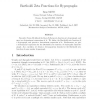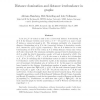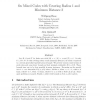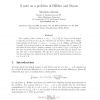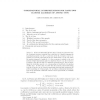COMBINATORICS
2007
13 years 11 months ago
2007
We show that the generating function (in n) for the number of walks on the square lattice with steps (1, 1), (1, −1), (2, 2) and (2, −2) from (0, 0) to (2n, 0) in the region 0...
COMBINATORICS
2007
13 years 11 months ago
2007
COMBINATORICS
2007
13 years 11 months ago
2007
COMBINATORICS
2007
13 years 11 months ago
2007
Recently, Storm [8] defined the Ihara-Selberg zeta function of a hypergraph, and gave two determinant expressions of it. We define the Bartholdi zeta function of a hypergraph, a...
COMBINATORICS
2007
13 years 11 months ago
2007
COMBINATORICS
2007
13 years 11 months ago
2007
COMBINATORICS
2007
13 years 11 months ago
2007
The known bijections on Dyck paths are either involutions or have notoriously intractable cycle structure. Here we present a size-preserving bijection on Dyck paths whose cycle st...
COMBINATORICS
2007
13 years 11 months ago
2007
For a prime p and a vector ¯α = (α1, . . . , αk) ∈ Zk p let f (¯α, p) be the largest n such that in each set A ⊆ Zp of n elements one can find x which has a unique repr...
COMBINATORICS
2007
13 years 11 months ago
2007
Let µ (G) and µmin (G) be the largest and smallest eigenvalues of the adjacency matrix of a graph G. Our main results are: (i) Let G be a regular graph of order n and finite di...
COMBINATORICS
2007
13 years 11 months ago
2007
![The Number of [Old-Time] Basketball Games with Final Score n: n where the Home Team was Never Losing but also Never Ahead by Mor The Number of [Old-Time] Basketball Games with Final Score n: n where the Home Team was Never Losing but also Never Ahead by Mor](https://www.sciweavers.org/files/imagecache/thumbnail/default/content.jpg)
